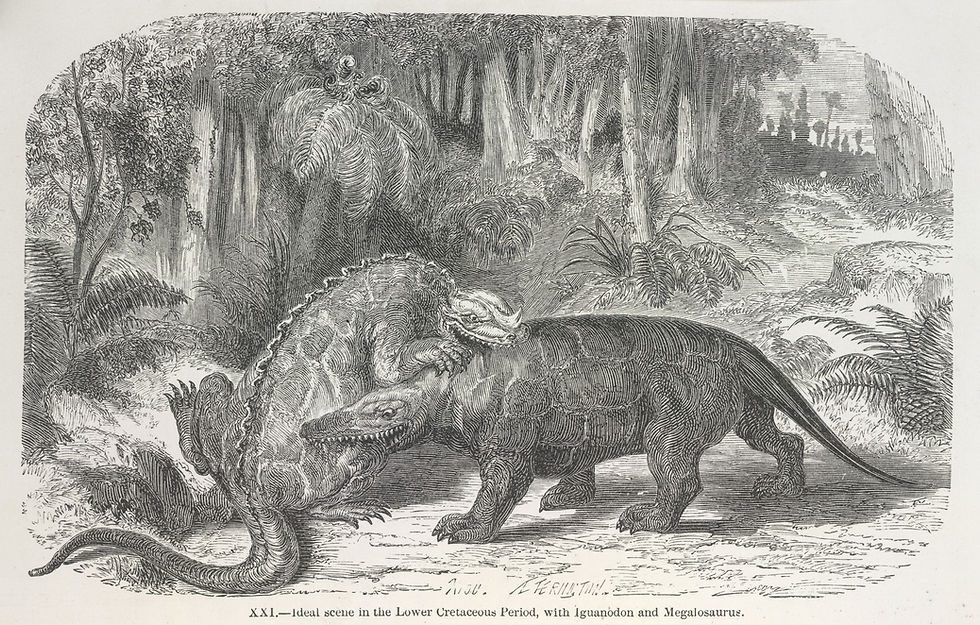Good Ol' Days
- Theartist Henley
- Oct 14
- 4 min read

Lately, I've observed an online trend leaning towards nostalgia for the 1980s, late 1990s, and early 2000s. I've seen an increase in video shorts and social media sites touting how much simpler things seemed to be back then.
These videos often feature gentle, melancholic music alongside vintage footage of children biking around their neighborhoods or playing with retro video games and toys. Additional scenes might include classic cars cruising through quaint, Mayberry-esque towns, enhanced by '70s or '80s style Yacht Rock music.
The passion for vintage scenes extends to scenes beyond humans. There has been a plethora of retro Paleo-art sites cropping up, with vintage art of dinosaurs and other prehistoric animals drawn with the wildly inaccurate anatomy of the time. Consider the scene below by French illustrator Édouard Riou. Created in 1865, it depicts a supposedly ideal scene from the late Cretaceous period with a carnivorous Megalodon attacking an Iguanodon - never mind that current science says that Megalodon lived some 166 million years ago during the middle Jurassic period, millions of years prior to the Cretaceous period.

Or consider this classic scene by one of the greatest (and my personal favorite) paleo-artists, Charles R. Knight, featuring a Tyrannosaurus confronting a Triceratops. Awesome painting- but still considered anatomically inaccurate by current thought.

Still, many look with fondness on these old illustrations because of nostalgia; they remind us of the dinos that we 'grew up with', and hence, our childhood.
To bring it out of prehistory and back into the modern era, I'm going to bring to your attention an American artist that many have considered nearly synonymous with nostalgia; Norman Percevel Rockwell.

Norman Rockwell was known for his depictions of idealized American culture in the United States during the mid-twentieth century. Although a prolific artist, his work was somewhat underappreciated during his time; many thought his art was too idealized, too sugary-sweet in its depiction of American life. He was sometimes referred to as an 'illustrator', which was meant in a derogatory manner, but a title that Rockwell embraced, nonetheless. He was probably most well-known for his iconic work on the Saturday Evening Post, for which he illustrated the covers for the better part of fifty years.

As mentioned, Rockwell often depicted the brighter, sunnier side of American life, but even he recognized that there were sides to life that weren't all sunshine and rainbows. Consider, for example, his painting The Problem We All Live With. Like the Runaway, it's also considered an iconic image, but of course for completely different reasons.

This painting depicts Civil Rights activist Ruby Bridges as a child, attending formerly whites-only William Frantz Elementary School in New Orleans on November 14, 1960.
And this is the problem with longing for the 'good 'ol days', 'the way things used to be'. Often, it turns out these good 'ol days weren't quite as good as we remember when viewed through the lens of inordinate nostalgia. The quote from Frank Herbert's book The God Emperor of Dune sums it up nicely;
"Most believe that a satisfactory future requires a return to an idealized past, a past which never in fact existed."
Or, as another book I sometimes quote from puts it:
“Do not say: ‘Why has it happened that the former days proved to be better than these?’ for it is not due to wisdom that you have asked about this.” - Ecclesiastes 7:10, Reference Bible
Both these quotes have basically the same meaning- that thinking of the past as somehow ‘better’ than the time we are currently experiencing can be deceptive. Don’t get me wrong; I’m not immune to romanticizing the past and past parts of my life-I wanted to be a paleontologist as a kid and still have some of my old toy dinos to this day. Also, it’s currently the autumn season, and I tend to get very nostalgic during this time of year. As mentioned in an earlier post, I've lost many people who were close to me, and this has also led me to think about the past quite a bit.
Also, with so much…unrest in the world right now, it’s easy to get swept up in the feeling that the past was somehow better. But was it really? Take a look at The Problem again. Are we so sure that we really want to go back there? And it doesn’t even have to be that particular era. Any time you pick will have plenty of problems of its own if you look at it objectively.
Recently, videos similar to the one below have surfaced across the internet, capturing the current mood in our society. However, it's important to maintain perspective—our memories can be flawed and biased, and the past wasn't always as ideal as we might recall. While we might be tempted to 'make things great again', suggesting that the past was the best, it's more beneficial to focus on improving our present.
More about Norman Rockwell, Ruby Bridges, and The Problem We All Live With:


Comments